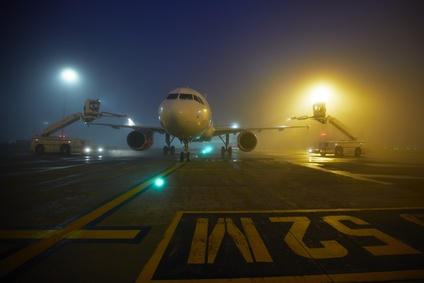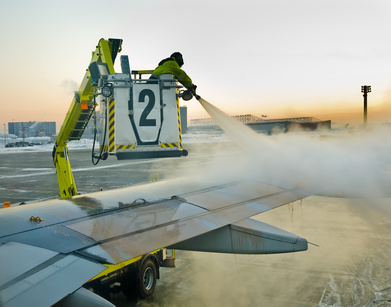
Newsletter Subscribe
Enter your email address below and subscribe to our newsletter

Enter your email address below and subscribe to our newsletter

In the world of Aviation, every season brings new challenges. In the springtime the heavy rain arrives. In the summer the severe thunderstorms roll in. With the fall come the high winds, and finally, as we have already started to see, with winter comes ice and snow. Dealing with weather is an important part of airport life, and must be done accurately in order to avoid delays and cancellations. With the ice and snow already falling around the country, the season for de-icing has begun. Unfortunately though, with de-icing comes slower departure rates and numerous delays, but with it also comes safety!

On January 13, 1982, Air Florida Flight 90 crashed on departure from Washington’s National Airport. The crash killed 78 people and was directly attributed to snow and ice buildup on the aircraft. According to the National Transportation Safety Board, the crew failed to follow proper procedures for dealing with ‘winter operations” and therefore could have been avoided. As a result of this tragic accident, airlines have made significant changes to their operating procedures during winter months where conditions of ice and snow are potential factors.
When it comes to ice, one of the biggest concerns is crew failing to recognize it. Airlines have put strict procedures in place to ensure that crewmembers are properly trained to deal and look for ice accumulation on the aircraft. During the pre-departure walk around, the crew must identify whether or not there is ice on the critical surfaces of the aircraft, such as the wings, tail, flaps, engines and ailerons. This walk-around will help determine whether or not the aircraft needs to be de-iced. If the aircraft does not have any ice on it, the pilots must then consider the chance of precipitation falling on the aircraft during taxiing before it has a chance to get airborne. If precipitation is present in the form of visible moisture such as snow, rain, ice pellets or even fog, there is a good chance that the plane will need to be de-iced.
Once it is determined that an aircraft needs to be de-iced, pilots will then taxi their plane to a designated area prior to departure so that the procedure can take place. This process typical takes 10-15 minutes (depending on the size of plane and number of planes ahead of you) and consists of 3 or more de-icing trucks that circle the aircraft spraying a solution on all the surfaces. Before the plane is ready to go, the de-icing crew must then re-inspect the aircraft to make sure that it is free of all containments and safe for flight.

You might notice that your plane looks a bit like a neon glow stick once the whole de-icing process is over. De-icing and anti-icing fluids are usually brightly colored so that it’s easy for ground crew to identify where they have already sprayed. Think of it as a big highlighter, highlighting the exact areas on the aircraft that have received fluid, while insuring that any missed areas get covered properly. These colors can vary from neon green to orange to an almost straw colored liquid.
As simple as all this sounds, the whole process is actually quite complicated. Before an aircraft is treated, ground crews must first decide which de-icing fluids they need to use, as well as whether or not they need to follow up with anti-icing treatments. De-icing is done using IR heating (infer-red heating) or with chemicals that are mixed with water, while anti-icing is done with a solution made 100% of chemicals that have non-Newtonian properties. Anytime there is a chance of further precipitation, crews will then follow the de-icing process with anti-icing treatments. This anti-icing procedure protects the aircraft by using chemicals that absorb the ice and snow. When the aircraft accelerates down the runway, the anti-ice fluid shears away from the skin of the aircraft carrying away any ice or snow that has built up, leaving the wing clean and safe for flight. Once airborne and traveling at speeds of over 500 miles an hour, ice and snow have nothing to cling to, further protecting the plane.
Anti-icing solutions also come with drawbacks and limitations. When calculating how long the anti-icing solutions are effective for, crews must consider the current temperature, the type of precipitation that is falling, as well as the time of day they are departing. All of these factors determine an aircrafts “holdover” time. This time measures how long an aircraft can sit in icing conditions before departure. Holdover times can range from hours in the most benign conditions, to as little as 15 minutes in more moderate conditions like light snow or ice pellets. In more severe conditions like freezing rain, anti-icing solutions will offer no protection and takeoffs will not be authorized.
De-icing is an important activity during the winter months and all airlines must be prepared for this when flying to colder locations. Unfortunately de-icing doesn’t come cheap and can cost airlines a ton of money. The price for de-icing an average passenger aircraft can cost an airline well over $7,000 for just one coating, and can wipeout the entire profit margin for that flight.

Although de-icing is costly and time-consuming, it is unavoidable. An airlines primary objective is to keep its passengers safe, especially when dealing with challenging conditions like snow and ice. De-icing an airplane will ensure that you get to your destination safely, so be patient with this process and remind yourself why it’s important. If you’re lucky enough to be sitting near a window seat, shoot your grounds crew a thumbs up for all the hard work they do and for helping to keep you safe!!